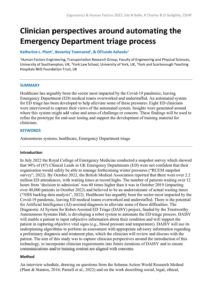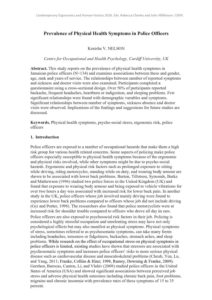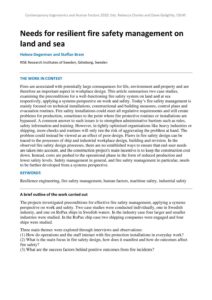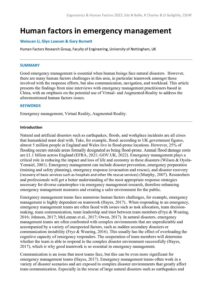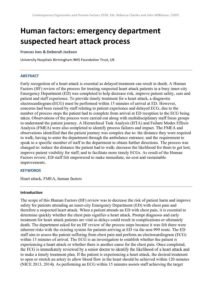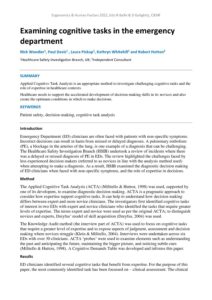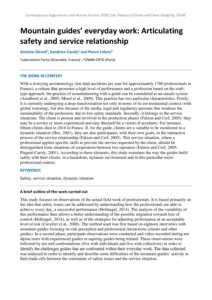Emergency services
Clinician perspectives around automating the Emergency Department triage process
| Document | Author Katherine L. Plant, Beverley Townsend, & OlTunde Ashaolu |
| Abstract Healthcare has arguably been the sector most impacted by the Covid-19 pandemic, leaving Emergency Department (ED) medical teams overworked and understaffed. An automated system for ED triage has been developed to help alleviate some of these pressures. Eight ED clinicians were interviewed to capture their views of the automated system. Insights were generated around where this system might add value and areas of challenge or concern. These findings will be used to refine the prototype for end-user testing and support the development of training material for clinicians. |
Prevalence of Physical Health Symptoms in Police Officers
| Document | Author Kenisha V. NELSON |
| Abstract This study reports on the prevalence of physical health symptoms in Jamaican police officers (N=134) and examines associations between these and gender, age, rank and years of service. The relationships between number of reported symptoms and sickness and doctor visits were also examined. Participants completed a questionnaire using a cross-sectional design. Over 50% of participants reported backache, frequent headaches, heartburn or indigestion, and sleeping problems. Few significant relationships were found with demographic variables and symptoms. Significant relationships between number of symptoms, sickness absence and doctor visits were observed. Implications of the findings and suggestions for future studies are discussed. |
Needs for resilient fire safety management on land and sea
| Document | Author Helene Degerman and Staffan Bram |
| Abstract Fires are associated with potentially large consequences for life, environment and property and are therefore an important aspect in workplace design. This article summarises two case studies, examining the preconditions for a well-functioning fire safety system on land and at sea respectively, applying a systems perspective on work and safety. Today’s fire safety management is mainly focused on technical installations, constructional and building measures, control plans and evacuation routines. Fire safety installations could meet all regulative requirements and still create problems for production, sometimes to the point where fire protective routines or installations are bypassed. A common answer to such issues is to strengthen administrative barriers such as rules, safety information and training. However, in tightly optimised organisations like heavy industries or shipping, more checks and routines will only run the risk of aggravating the problem at hand. The problem could instead be viewed as an effect of poor design. Flaws in fire safety design can be traced to the processes of ship and industrial workplace design, building and revision. In the observed fire safety design processes, there are no established ways to ensure that end-user needs are taken into account, and the construction project's main incentive is to keep the construction cost down. Instead, costs are pushed to the operational phase in the form of reduced production and lower safety levels. Safety management in general, and fire safety management in particular, needs to be further developed from a systems perspective. |
Human factors in emergency management
| Document | Author Weixuan Li, Glyn Lawson & Gary Burnett |
| Abstract Good emergency management is essential when human beings face natural disasters. However, there are many human factors challenges in this area, in particular teamwork amongst those involved with the response efforts, but also communication, navigation, and workload. This article presents the findings from nine interviews with emergency management practitioners based in China, with an emphasis on the potential use of Virtual- and Augmented-Reality to address the aforementioned human factors issues. |
Human factors: emergency department suspected heart attack process
| Document | Author Frances Ives & Deborah Jackson |
| Abstract Early recognition of a heart attack is essential as delayed treatment can result in death. A Human Factors (HF) review of the process for treating suspected heart attack patients in a busy inner-city Emergency Department (ED) was completed to help decrease risk, improve patient safety, care and patient and staff experience. To provide timely treatment for a heart attack, a diagnostic electrocardiogram (ECG) must be performed within 15 minutes of arrival at ED. However, concerns had been raised by staff relating to patient experience and delayed ECG, due to the number of process steps the patient had to complete from arrival at ED reception to the ECG being taken. Observations of the process were carried out along with multidisciplinary staff focus groups to understand the patient journey. A Hierarchical Task Analysis (HTA) and Failure Modes Effects Analysis (FMEA) were also completed to identify process failures and impact. The FMEA and observations identified that the patient journey was complex due to: the distance they were required to walk; having to enter the department through the ambulance entrance; and the requirement to speak to a specific member of staff in the department to obtain further directions. The process was changed to: reduce the distance the patient had to walk; decrease the likelihood for them to get lost; improve patient visibility for staff; and to facilitate more timely ECGs. As result of the Human Factors review, ED staff felt empowered to make immediate, no-cost and sustainable improvements. |
Examining cognitive tasks in the emergency department
| Document | Author Nick Woodier, Paul Davis, Laura Pickup, Kathryn Whitehill & Robert Hutton |
| Abstract Applied Cognitive Task Analysis is an appropriate method to investigate challenging cognitive tasks and the role of expertise in healthcare contexts. Healthcare needs to support the accelerated development of decision-making skills in its novices and also create the optimum conditions in which to make decisions. |
Mountain guides’ everyday work: Articulating safety and service relationship
| Document | Author Antoine Girard, Sandrine Caroly and Pierre Falzon |
| Abstract With a worrying accidentology (ten fatal accidents per year for approximately 1700 professionals in France), a culture that promotes a high level of performance and a profession based on the craft-type approach, the practice of mountaineering with a guide can be considered as an unsafe system (Amalberti et al., 2005; Morel et al., 2009). This practice has two particular characteristics. Firstly, it is currently undergoing a deep transformation not only in terms of its environmental context (with global warming), but also because of the media, legal and regulatory pressure that weakens the sustainability of the profession, due to low safety standards. Secondly, it belongs to the service situations. The client is present and involved in the production phases (Falzon and Cerf, 2005): they may be a novice or more experienced and may themself be a victim of accidents. For instance, fifteen clients died in 2018 in France. If, for the guide, clients are a variable to be monitored in a dynamic situation (Hoc, 2001), they are also participants, with their own goals, in the interactive process of the service relationship (Falzon and Cerf, 2005). This service situation, where a professional applies specific skills to provide the service requested by the client, should be distinguished from situations of cooperation between two operators (Falzon and Cerf, 2005; Flageul-Caroly, 2001). According to these elements, this study examines the way the guides build safety with their clients, in a hazardous, dynamic environment and in this particular socio-professional context. |

